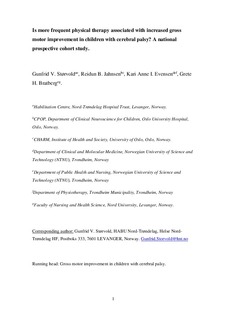Is more frequent physical therapy associated with increased gross motor improvement in children with cerebral palsy? A national prospective cohort study
Journal article, Peer reviewed
Accepted version
Permanent lenke
http://hdl.handle.net/11250/2584891Utgivelsesdato
2018Metadata
Vis full innførselSamlinger
Sammendrag
Purpose: To investigate the association between physical therapy frequency and gross motor improvement in children with cerebral palsy (CP).
Materials and methods: This is a prospective cohort study of 442 children aged 2–12 years, Gross Motor Function Classification System levels I–V, from the Cerebral Palsy Follow-up Program and the Cerebral Palsy Register of Norway. Outcome was change in reference percentiles for the Gross Motor Function Measure (GMFM-66) between two subsequent assessments (N = 1056) analyzed in a linear mixed model.
Results: It was a dose response association between physical therapy frequency and gross motor improvement. Mean change was 4.2 (95% CI: 1.4–7.1) percentiles larger for physical therapy 1–2 times per week and 7.1 (95% CI: 2.6–11.6) percentiles larger for physical therapy >2 times per week, compared to less frequent physical therapy when analyzed in a multivariable model including multiple child and intervention factors. The only statistically significant confounder was number of contractures which was negatively associated with gross motor improvement.
Conclusions: When gross motor improvement is a goal for children with CP, more frequent physical therapy should be considered.
Implications for rehabilitation
- In general, the gross motor development of Norwegian children with cerebral palsy was as expected according to the reference percentiles for the GMFM-66.
- When gross motor improvement is a goal for children with cerebral palsy, high-frequency physical therapy should be considered.
- Contractures should be addressed in order to optimize gross motor improvement for children with cerebral palsy.
